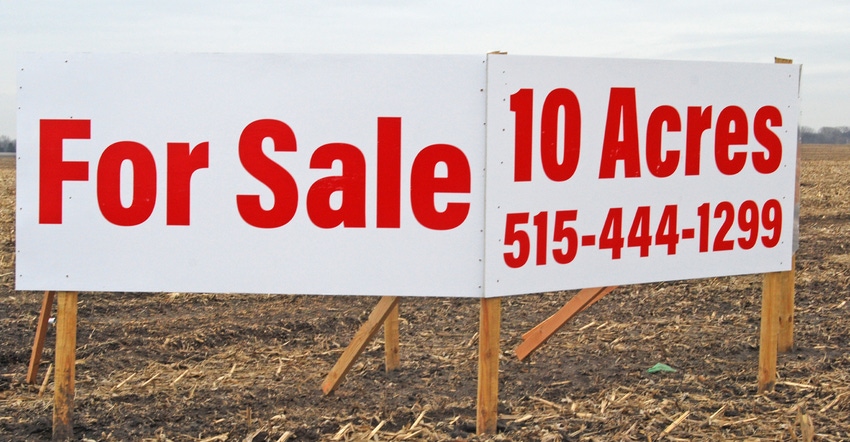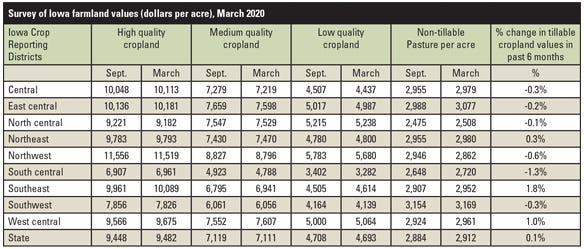April 1, 2020

The average acre of tillable Iowa cropland increased in value by 0.1% from September to March. Medium-quality cropland is valued at $7,111 per acre; high-quality land is $9,482 per acre, according to the latest survey by the Iowa Chapter of the Realtors Land Institute. Survey results were released March 25.
Conducted every six months, the survey asks agents who specialize in farmland sales, along with farm managers and appraisers, to estimate the value of farmland as of March 1 and Sept. 1 each year. The estimates are for tillable cropland with a sale price on a cash basis. Pasture and timberland values are reported separately.
The statewide increase in cropland values of 0.1% for the recent six-month period, combined with the 0.8% increase reported in September, indicates an average increase of 0.9% from March 2019 to March 2020.
Southeast with largest increase
As the accompanying table shows, results for the last six months are consistent among various areas of the state, with less than a 1% change in most crop reporting districts. The southeast Iowa district had the largest increase with a 1.8% rise, and the south-central district had the largest decrease with a 1.3% decline.

Source: Iowa Chapter of Realtors Land Institute
Survey participants cited several factors influencing farmland sales. Major supporting factors include a tight supply of quality farms on the market, along with USDA’s Market Facilitation Program payments, low interest rates and above-average yields in many areas. Major negative factors include continued uncertainty with world trade and low commodity prices that are straining farm incomes.
“There were some fluctuations during the six-month period from last fall to this spring, but for the most part, land values in Iowa stayed steady, as this survey shows,” says Kyle Hansen, a broker with Hertz Real Estate Services at Nevada in central Iowa. He is past president of the Realtors Land Institute’s Iowa Chapter and is a former coordinator of the survey.
Is COVID-19 causing hesitation?
These latest survey results are based on the views of respondents as of March 1, prior to the COVID-19 virus situation developing into a global pandemic and becoming a bigger threat to the U.S. population and economy. So, what’s been happening since the survey was taken, regarding land sales this spring?
“We’ve seen a slight decrease in farmland sales activity,” Hansen says. “There is more uncertainty among sellers wanting to sell land, and some buyers are uncertain if they should be buying land during these unsettling times. Ag export markets have been hurt and crop and livestock prices have lost strength. The situation with the general economy is unsure.”
However, at the end of March, “we still haven’t seen much of a downtrend in land prices,” he notes. “As the virus threat continues, we are seeing some hesitation among potential buyers and sellers. Currently, we don’t have enough land sales taking place to say where land prices are heading. Sales in March have been on par with what we would have forecast prior to March. We’ve also seen some areas with land sales that have been a little lighter than they might have been if we didn’t have the uncertainty caused by the coronavirus disruption.”
Farmland investment continues
“There isn’t a solid trend to give a direction as to how all this current uncertainty will impact future land sales and prices,” Hansen says. “Also, this is happening during a time of year that’s typically a slower period for land sales anyway. Farmers are preparing for the busy spring planting season so there are fewer farmland sales. You need to put this into proper perspective. This slowdown in sales hasn’t happened during the fall, which is when farmland sales volume has its highest period of the year.”
Will investment in farmland continue? While there is some hesitation among buyers and sellers, are people still trying to make investments based on optimism for the future?
“I think so,” Hansen says. “We still get phone calls. I’ve been able to list properties for sale. People inquire about our listings. Other farm real estate agents are seeing the same activity. It’s a slower time in general, as it is every spring when farmers are busy. But people are still looking to buy land. A lot of investors have had issues with stock market declines and are seeking alternative places to invest. One of those is farmland.
“If they decided to take some money out of the stock market previously, they may want to reinvest those funds and are looking for investment properties. They want to put the money into a hard asset. Land is a great opportunity for that, but this is definitely a case-by-case situation.”
About the Author(s)
You May Also Like






